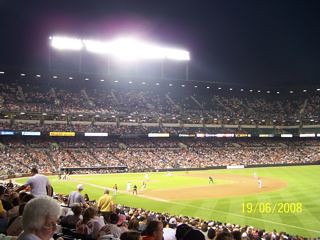
When Oriole Park opened, it put another HOK-designed project, New Comiskey Park, to complete shame. It had open concourses, easy circulation, and that oh-so-retro look. Nowadays, it suffers a bit compared to the newest parks but for the most part still holds it own. That's reflected in the fanbase, much of which is young and comes mostly to hang out.
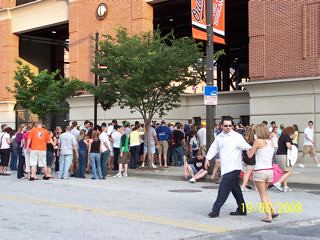
The picture above was taken at 7:36 p.m., over a half hour into the O's-Stros duel. It took me another 20 minutes to get a ticket. By the time I got inside the north Eutaw St gate, it was the middle of the third. The kids in line with me didn't appear to care much for the action on the field, although half the crowd adorned Nick Markakis jersey shirts. The final announced crowd was 31,480, nearly 10,000 more than average. Some of that boost may have been attributable to the team's recent success. The O's were on the verge of a three-game sweep going into Thursday night.
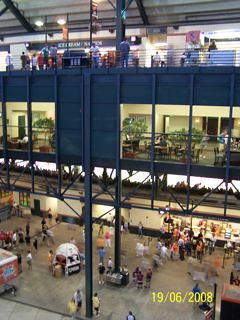
This picture pretty much sums Camden Yards. At the bottom is the field level concourse. Unlike most new ballparks, the tunnels/vomitories from the concourse empty into the middle of the field level seating. You can see the back of the upper section cantilevered over the concourse. The net effect is that fans on the concourse are cut off from the action. It's odd that only baseball really emphasizes the idea of the open concourse, the other three major sports all sport venues with concourses separate from the action. Yet the open concourse really enhances fan experience, that's why even upper decks are getting the treatment.

Now compare the Camden Yards concourse, above, to Nats Park's lower concourse.
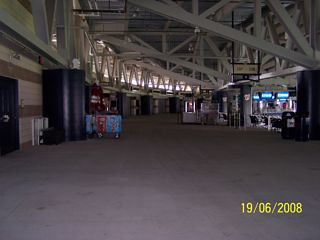
Massive difference in ambient light, right? This tends to make the concourse feel a bit claustrophobic, especially when there's a lot of foot traffic. At Camden Yards, not so much. There's always an available refuge area at the outer edge of the concourse, which happens to be at street level. Is one really that much better than the other? I can't say. Both have readily apparent pros and cons. PETCO Park tried to have it both ways by having concourses split so that they're open on both sides with a block of services in between. I find it a bit confusing.
Also, take a look at the structural work. At Camden Yards, the steel beams are smaller but in greater quantity. At Nationals Park they use massive beams and trusses that are set further apart. Is the newer treatment more practical, or more for effect? It gets a big shrug from me. To the same end, Nats Park has huge concrete columns supporting the truss system.
The thing I appreciate the most about Camden Yards is its use of materials. All stadium have mixtures of precast concrete and steel, along with some kind of external treatment. While HOK has really emphasized steel in its most recent parks, Camden Yards is different in that it gives equal treatment to both materials, as well as the brick façade.
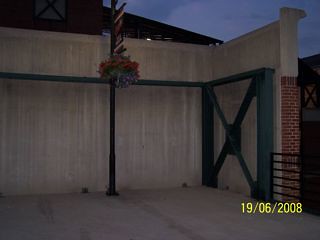
The ramp landing above shows this philosophy. The brick isn't a thin layer as it is at AT&T Park, it's either one or two full bricks deep. It even wraps around so that it's exposed to fans using the ramp. Not to be forgotten, there's a steel form there to remind everyone what's really carrying the load. It's that sense of shared purpose that makes Camden Yards so good, so unique. Sometimes I wonder what's happened to HOK's parks since then. It can't just be a budgetary issue, can it?

Eutaw Street is the element that every ballpark since then (that has had available space) has tried to copy. It's perfect in terms of execution. Perhaps it's too good. The green canopy in the middle left is the oft-mentioned Boog's BBQ stand. The line for it stretched almost completely to the gate at the far left. Chances are if you were in the line you were waiting for 30 minutes just to order. I'm sure it's good, but really what are they doing? Par-cooking then heating up the food? Is that what they're waiting for?
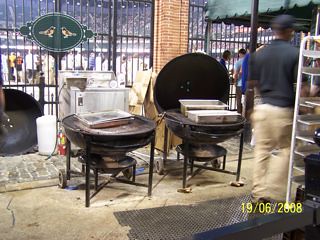
I've been working with a small smoker recently, and much of the time there is no comparison between merely grilled food and truly barbecued (via smokehouse/smoker) food.
Tonight I'm off to Citizens Bank Park, home to the Phillies' answer to Eutaw Street, Ashburn Alley.

0 comments:
Post a Comment